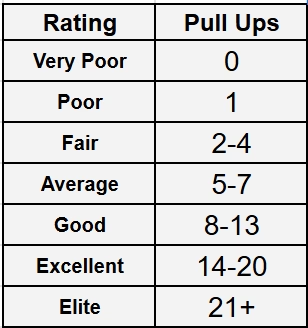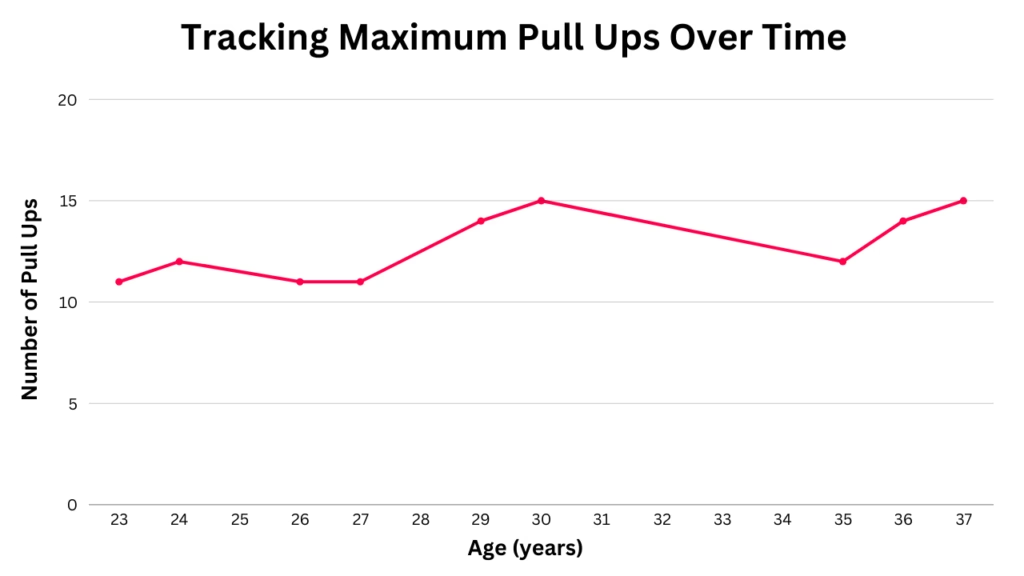
Pull ups are an excellent upper body strength exercise and a popular choice for physical fitness tests. Completing a pull up with correct form requires a good baseline level of strength, which is an indication of overall fitness and health.
How to Complete a Pull Up Test
The pull up test outlined here involves completing the maximum number of consecutive pull ups with no rest. Before we get into the specifics, let’s start with the basic pull up technique.
How to Perform a Pull Up
- Find a secure, horizontal overhead bar that can support your body-weight
- Grip the bar with an overhand grip (palms facing away from you), hands slightly greater than shoulder width apart
- Lift the feet off the floor, allowing the body to hang so that your arms are fully extended
- Tense your glutes and abs to help stabilise the body
- Pull the body upwards by bending the elbows, avoiding any swinging of the body
- At the top of the movement, the chin should be over the bar, but don’t reach with the neck to accomplish this
- Pause briefly, before lowering under control to the starting position, with arms fully extended
Below is a demonstration of correct form, though you will notice a breakdown in form under fatigue.
Note that pull ups are a demanding exercise, particularly for women, and an alternative test for women is the Flexed Arm Hang.
Warm Up and Exercise Tempo
In order to make it a fair assessment, the pull ups should be done with the same warm up each time and using a set tempo. It is also recommended to choose the same time of day, as muscle strength peaks in the afternoon. By keeping these variables the same, any future tests are a clearer measure of changes in true performance.
Below you will find a video of a pull up warm up adapted from a program called 7 Weeks to 50 Pull ups. This can be completed prior to your maximum pull up test, as well as before any workouts involving pull ups. It’s approximately 8 minutes long and can be followed along in real time.
As for the tempo, I personally find that 30 beats per minute, meaning 15 pull ups per minute, is the right tempo for me. It is a balance between feeling too slow early on and having the time to squeeze out reps under fatigue. Experiment for yourself with the tempo that yields your best results. A google search for the word “metronome” should bring up an adjustable metronome, as seen below.

Simply set the metronome nearby at a volume which you can hear while exercising. Be sure to pause your pull ups at the top and bottom of the movement until you hear the next beat.
You may find your total number of reps decreases with this method, but what matters is to compare it to your results from future tests using the same approach.
What Do My Results Mean?
Here is the normative data for adult males when it comes to consecutive pull ups. These could be considered the standards for males aged 18-30, beyond which the numbers are likely to steadily decline.

Note that this is a single data source and if you find different numbers online they could be equally relevant. For women, very few resources offer pull up standards, and again I would direct you to the Flexed Arm Hang Test.
Tracking Over Time
For most individuals, an upper body test like this can be completed once a year. There are a set of “essential” tests I believe everyone should be tracking each year, and I do not consider this to be essential. However, it is a good indication of overall upper body function and therefore has some value over time.

I’ve been tracking my own results consistently since turning 35 and found reference results from my training logs in my twenties. You can see that I’ve been capable of between 11 and 15 reps, alternating between “Good” and “Excellent”. My most recent result, at the age of 37, is the strongest I’ve been at this exercise test.
Outside of their value as a strength test, pull ups are a great exercise to incorporate into your gym routine. If they are too challenging you can use resistance bands to assist, and if they are easy it’s possible to add a weight belt. A bonus with this exercise is that it has carryover to improving your grip strength!


Leave a Reply